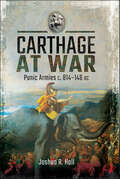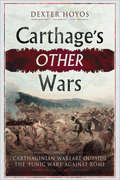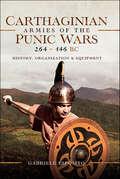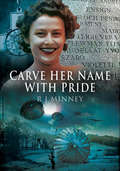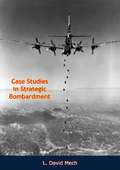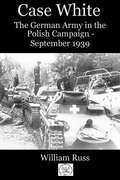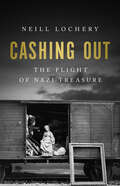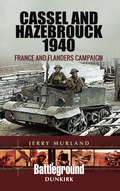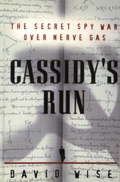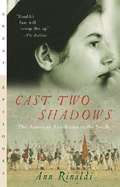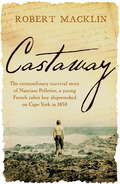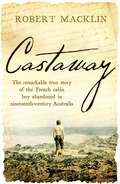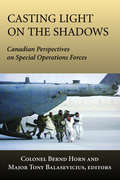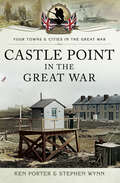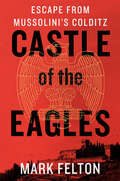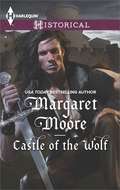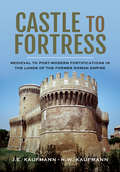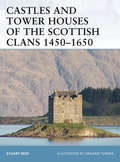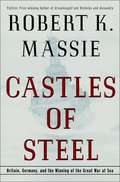- Table View
- List View
Carthage at War: Punic Armies c. 814–146 BC
by Joshua R. HallThe Carthaginians are well known as Rome's great enemy of the three Punic wars and Hannibal, their greatest general, is a household name. While narrative histories of the Punic wars (especially the second) and biographies of Hannibal abound, there have been few studies dedicated to detailed analysis of Carthaginian armies and warfare throughout the city-state's entire existence. Joshua Hall puts that right with this in-depth study of their tactics, equipment, unit organization, army composition and operational effectiveness. Importantly, while the Second Punic War is rightly given prominence, this is not at the expense of the many earlier wars Carthage waged as she built and then defended her empire. Drawing on all the available archaeological and literary evidence, the author shows the development of Carthage's forces and methods of warfare from the ninth century BC to the city's demise. The result is the most in-depth portrait of the Carthaginian military available in English.
Carthage's Other Wars: Carthaginian Warfare Outside the 'Punic Wars' Against Rome
by Dexter Hoyos&“A very good read . . . and a reminder that the Romans were hardly the only imperialist warmongers of the ancient world.&” —StrategyPage Carthage was the western Mediterranean&’s first superpower, long before Rome, and her military history was powerful, eventful, and checkered even before her &“Punic Wars&” against Rome. Although characterized in the surviving sources and modern studies as a predominantly mercantile state, Carthage fought many wars, both aggressive and defensive, before and in between the contests with the Roman parvenus. The Greek states of Sicily, above all Syracuse under its tyrants Dionysius the Great and then Agathocles, were her most resolute opponents, but in North Africa itself, in Sardinia, and later on in Spain she won—and sometimes lost—major wars. This is the first full-length study dedicated to these other wars that furthered Carthage&’s interests for over half a millennium. Based firmly and analytically on ancient sources, it also offers the insight that Carthage, though usually considered a naval power, did more fighting on land than at sea—and with more success. Includes illustrations
Carthaginian Armies of the Punic Wars, 264–146 BC: History, Organization and Equipment
by Gabriele EspositoThe Carthaginians were undoubtedly the most formidable enemies of the ever-expanding Roman Republic, due to their sophisticated and often well-led military forces. Although the citizens of Carthage itself, a seafaring, mercantile state by tradition, may not have had the same military ethos as the Romans, they compensated by fielding varied multinational armies consisting of subject, allied and mercenary contingents, many of them recruited from the most famous warrior peoples of the Mediterranean. These included the incomparable Numidian light cavalry, the famed slingers of the Balearic islands, fierce Celts and skilled Spanish swordsmen, not forgetting the famous war elephants. During the first of the three conflicts that they fought against the Roman Republic – the famous Punic Wars – the Carthaginians completely reformed their land forces along Hellenistic lines and invited an experienced Spartan officer to command it. During the Second Punic War, they obtained a series of stunning victories over the Romans under the brilliant leadership of their own Hannibal Barca, marauding through Italy for some fifteen years. Gabriele Esposito reconstructs the history, organization and weapons of the Carthaginian military forces across the Punic Wars (264-146 BC). The weapons, armor and tactics of each of the various ethnic components is analyzed and the accessible text is supported by dozens of excellent color photographs, showing replica equipment in use.
Cartography: Navigating a Year in Iraq
by Katherine SchifaniCartography describes Katherine Schifani&’s time deployed in Iraq as a counterterrorism advisor with U.S. Special Forces in 2011. It is the story of one woman mapping the terra incognita of Iraq with questionable interpreters, nonexistent guidance, and an unclear purpose. It&’s the story of a gay woman serving under the military&’s Don&’t Ask, Don&’t Tell policy who realizes that the policy repeal she has long awaited is so overshadowed by a hostile environment that remaining closeted is more critical than ever. At the heart of Cartography is Schifani&’s quest to understand the Iraqi landscape and the Special Forces culture of American men she worked alongside as a gay woman and a member of the air force. Her memoir examines both the perils of being undertrained and underequipped to perform the job assigned to her in her role as an advisor and some of the unique situations—good and bad—her gender created in such an irregular combat environment. Schifani&’s deployment was an exercise in exploration, observation, and navigating a wholly foreign land.
Cartucho and My Mother's Hands
by Nellie CampobelloCartucho and My Mother's Hands are autobiographical evocations of a childhood spent amidst the violence and turmoil of the Revolution in Mexico. They are noteworthy, too, as one of the few first-person accounts of the female experience in the early years of the Mexican Revolution and unique in their presentation of events from a child's perspective.
Carve Her Name with Pride: The Story Of Violette Szabo (Pen and Sword Military Classics)
by R J MinneyThe thrilling and inspiring true story of Violette Szabo, the fearless British cloak-and-dagger agent who infiltrated Nazi occupied France. Switchboard operator and volunteer for the Women&’s Land Army, Violette Szabo was only twenty-two years old when her husband, Etienne, a captain in the French Foreign Legion, died at El Alamein. His death only made the resilient young widow more determined than ever to join England&’s war effort in World War II. To Violette&’s surprise, opportunity came at the request of Britain&’s Special Organization Executive. The purpose of the SOE was to conduct sabotage and espionage, and to aide local resistance movements in occupied Europe. Trained in secret in the Scottish Highlands, Violette became an expert in fieldcraft, covert navigation, and weapons and demolition. Then, on June 7, 1944, Szabo parachuted into Limoges. Her task was to coordinate the work of the French Resistance in the first days after D-Day. Violette Szabo was about to make history. &“Violette&’s bravery and spirit shine throughout&” this arresting true story of a heroic woman, undaunted by her missions, or the reality of the fate that would most likely await her in the closing years of war. R. J. Minney&’s stirring historical narrative was the basis for the classic 1959 film starring Virginia Mckenna and Paul Scofield (Portland Book Review).
Case Studies in Strategic Bombardment
by R. Cargill HallThis volume, the third in a series of historical case studies of important air power missions, addresses the most controversial (and arguably most significant) air power mission of all—strategic bombardment. The ability of aircraft and missiles to destroy or disrupt an enemy’s war-making potential and to break or weaken his will to resist, independent of the actions of ground and naval forces, has served as the central theme of air power theory and as the rallying point of air advocates, who made it the raison d’être for independent air forces. Written by well-known military historians, each chapter stands alone as a case study of an important stage in strategic air operations; combined, the chapters provide a comprehensive and insightful analysis of the theory and practice of strategic bombardment from its inception in World War I through the Gulf War of 1991.From “Boom” Trenchard and “Billy” Mitchell to John Warden and Charles Horner, the vision of air power prophets and airmen is tested against the reality of bureaucratic inertia, aircraft capability, technological advances, and bombing accuracy. Seldom in the twentieth century has technology fully met the demands of air power theory. Technology, of course, is the prime determinant of doctrine and operations. This exceptional volume surveys the entire history of strategic bombardment and its technology, from the Zeppelin and Gotha of the Great War to the F-117 and the penetrating precision guided bomb of the Gulf War. The reader will find technological advances—such as radar bombing and range-extending air-to-air refueling—that answer one problem only to produce new requirements and expectations that demand more advanced technology. Guided munitions, while offering remarkable precision, have underscored the problems of strategic intelligence collection and dissemination, and of locating and attacking both fixed and mobile targets.
Case White: The German Army in the Polish Campaign - September 1939
by William RussIn September 1939, Nazi Germany initiated the second world war by invading Poland. William Russ has compiled a highly detailed study of the German invasion of Poland in September 1939, examining, the actions of every group on a daily basis. This book explores the campaign down to the regimental level from the German perspective, listing every action as appropriate. The appendices provide a complete order of battle for the Germans and the Polish forces as well as their positions. There are sixty-nine maps of the campaign as well as information on armament and equipment.
Caseros: La batalla por la organización nacional
by Ignacio Zubizarreta Alejandro Rabinovich Leonardo CancianiA 170 años del 3 de febrero de 1852, prestigiosos especialistas revisitan, a la luz de las investigaciones historiográficas más recientes, la batalla de Caseros, el hecho fundante de la Argentina moderna, brindando un panorama enteramente novedoso sobre su carácter de acontecimiento bisagra de nuestra historia. El 3 de febrero de 1852 se enfrentan en la cañada de Morón, en las afueras de Buenos Aires, las tropas de Juan Manuel de Rosas y las de Justo José de Urquiza. Se trata, en total, de alrededor de cincuenta mil hombres. Al tiempo que termina la batalla puede decirse que nace un nuevo país. En efecto, la historia argentina se divide en un antes y después de Caseros. Si embargo, ese hito tan mentado es uno de los menos abordados en su especificidad y materialidad concretas por nuestra historiografía: para los trabajos que abordan el período previo, al llegar a Caseros ya está todo dicho; para los que tratan el período posterior, alcanza con una mención ritual de la batalla en la primera página. En ocasión de su 170° aniversario, este libro explica el misterio de un enfrentamiento que además de un enorme combate es un punto de inflexión en el devenir histórico de la Argentina porque en él confluyen, y en cierta medida se resuelven, buena parte de los conflictos y tensiones acumulados desde la Revolución de Mayo. A su faceta puramente militar se suman, pues, dimensiones políticas, económicas, diplomáticas y sociales de importancia trascendental. Por eso estas páginas reúnen a un grupo de especialistas que analizan Caseros en todas sus dimensiones desde la perspectiva privilegiada que ofrecen los aportes de la investigación académica más reciente.
Cashing Out: The Flight of Nazi Treasure, 1945–1948
by Neill LocheryWhen Nazis looked to flee Europe with stolen art, gems, and gold in tow, certain &“neutral&” countries were all too willing to assist them. By the end of January 1945, it was clear to Germany that the war was lost. The Third Reich was in freefall, and its leaders, apart from those clustered around Hitler in his Berlin bunker, sought to abscond before they were besieged. But they wanted to take their wealth with them. Their escape routes were diverse: Sweden and Switzerland boasted proximity, banking, and industrial closeness, while Spain and Portugal offered an inviting Atlantic coastline and shipping routes to South America. And in various ways, each of these so-called neutral nations welcomed the Nazi escapees, along with the clandestine wealth they carried. Cashing Out tells the riveting history of the race to intercept the stolen assets before they disappeared, and before the will to punish Germany was replaced by the political considerations of the fast-approaching Cold War. Bestselling author Neill Lochery here brilliantly recounts the flight of the Nazi-looted riches—the last great escape of World War II—and the Allied quest for justice.
Cassandra & Jane: A Jane Austen Novel (A\jane Austen Novel Ser. #1)
by Jill PitkeathleyThey were beloved sisters and the best of friends. But Jane and Cassandra Austen suffered the same fate as many of the women of their era. Forced to spend their lives dependent on relatives, both financially and emotionally, the sisters spent their time together trading secrets, challenging each other's opinions, and rehearsing in myriad other ways the domestic dramas that Jane would later bring to fruition in her popular novels. For each sister suffered through painful romantic disappointments—tasting passion, knowing great love, and then losing it—while the other stood witness. Upon Jane's death, Cassandra deliberately destroyed her personal letters, thereby closing the door to the private life of the renowned novelist . . . until now.In Cassandra & Jane, author Jill Pitkeathley ingeniously reimagines the unique and intimate relationship between two extraordinary siblings, reintroducing readers to one of the most intriguing figures in the world of literature, as seen through the eyes of the one person who knew her best.
Cassel and Hazebrouck 1940: France and Flanders Campaign (Battleground Dunkirk)
by Jerry MurlandThis is the first detailed account of the rearguard action that took place between 25 and 29 May 1940 at Cassel and Hazebrouck on the western perimeter of the Dunkirk Corridor. By 25 May the decision to evacuate the BEF via Dunkirk had already been taken, Lord Gort, commanding the BEF in France, had given instructions to Lieutenant General Sir Ronald Adam to relinquish his command of III Corps and prepare a perimeter of defense around Dunkirk. As part of the western defensive line of the Dunkirk Corridor, 145 Brigade were deployed to Cassel and Hazebrouck with the instructions to hold the two towns until the last man. Under the command of Brigadier Nigel Somerset, the brigade occupied Hazebrouck with the infantry of 1st Buckinghamshire Battalion and Cassel with the 4/Ox and Bucks Light infantry together with the regulars of the 2nd Battalion Gloucestershire Regiment. Attached to Somersets meager force was a number of units that had previously been part of two of Gorts ad hoc formations—Macforce and Woodforce, and it was with these men that the two towns were fortified against the advancing German armored divisions.While Hazebrouck was overwhelmed very quickly, the hilltop town of Cassel held out for much longer with German forces failing to consolidate any penetration of the perimeter. The book looks closely at the deployment of units in both towns and focuses on the individuals involved in the defense and the subsequent breakout, which ended in capture or death for so many. There are two car tours that explore the surrounding area of Cassel and the deployment of platoons within Hazebrouck. These are supplemented by two walking tours, one in Cassel itself and the second further to the west of the town around the area controlled by B and D Companies of the 2nd Gloucesters. The book is illustrated with ten maps and over 100 modern and contemporary photographs.
Cassidy's Run
by David WiseCassidy's Run is the riveting story of one of the best-kept secrets of the Cold War--an espionage operation mounted by Washington against the Soviet Union that ran for twenty-three years. At the highest levels of the government, its code name was Operation shocker. Lured by a double agent working for the United States, ten Russian spies, including a professor at the University of Minnesota, his wife, and a classic "sleeper" spy in New York City, were sent by Moscow to penetrate America's secrets. Two FBI agents were killed, and secret formulas were passed to the Russians in a dangerous ploy that could have spurred Moscow to create the world's most powerful nerve gas.Cassidy's Run tells this extraordinary true story for the first time, following a trail that leads from Washington to Moscow, with detours to Florida, Minnesota, and Mexico. Based on documents secret until now and scores of interviews in the United States and Russia, the book reveals that: ¸ more than 4,500 pages of classified documents, including U.S. nerve gas formulas, were passed to the Soviet Union in exchange for hundreds of thousands of dollars ¸ an "Armageddon code," a telephone call to a number in New York City, was to alert the sleeper spy to an impending nuclear attack--a warning he would transmit to the Soviets by radio signal from atop a rock in Central Park ¸ two FBI agents were killed when their plane crashed during surveillance of one of the Soviet spies as he headed for the Canadian border ¸ secret "drops" for microdots were set up by Moscow from New York to Florida to WashingtonMore than a cloak-and-dagger tale, Cassidy's Run is the spellbinding story of one ordinary man, Sergeant Joe Cassidy, not trained as a spy, who suddenly found himself the FBI's secret weapon in a dangerous clandestine war.
Cassidy’s Battalion
by Colonel Samuel L. A. Marshall Gen. Jacob E. SmartThe chief threat to the UTAH BEACH landings was the German coastal battery located just to the westward of the village of St Martin De Varreville. It had been the target of air bombardment in the preceding days but the results were not known. The fate of the northern half of the operation could have turned on it; the assured destruction of the Battery became a chief preoccupation of the 502d Airborne Infantry Regiment led by Lt. Colonel Patrick Cassidy. Widely scattered in the drop Cassidy and the paratroops under him were still determined to succeed in their objectives. In this short monograph produced by the European Theater of Operation historian S.L.A. Marshall, which was based on the oral testimony collected from the men involved, we follow Cassidy and his men as they attempt to achieve their important objectives.
Cast Two Shadows: The American Revolution in the South
by Ann RinaldiIn South Carolina in 1780, fourteen-year-old Caroline sees the Revolutionary War take a terrible toll on her family and friends, and comes to understand the true nature of war.
Castaway: The extraordinary survival story of Narcisse Pelletier, a young French cabin boy shipwrecked on Cape York in 1858
by Robert MacklinIn 1858, 14-year-old Narcisse Pelletier sailed from Marseilles in the French trader Saint-Paul. With a cargo of Bordeaux wine, they stopped in Bombay, then Hong Kong, and from there they set sail with more than 300 Chinese prospectors bound for the goldfields of Ballarat and Bendigo. Around the eastern tip of New Guinea, however, the ship became engulfed in fog, struck reefs and ran aground. Scrambling aboard a longboat, the survivors undertook a perilous voyage, crossing almost 1000 kilometres of the Coral Sea before reaching the shores of the Daintree region in far north Queensland, where, abandoned by his shipmates and left for dead, Narcisse was rescued by the local Aboriginal people. For seventeen years he lived with them, growing to manhood and participating fully in their world - until in 1875 he was discovered by the crew of a pearling lugger and wrenched from his Aboriginal family. Taken back to his 'real' life in France, he became a lighthouse keeper, married and had another family, all the while dreaming of what he had left behind...Drawing from firsthand interviews with Narcisse after his return to France and other contemporary accounts of exploration and survival, and documenting the spread of European settlement in Queensland and the brutal frontier wars that followed, Robert Macklin weaves an unforgettable tale of a young man caught between two cultures in a time of transformation and upheaval.
Castaway: The remarkable true story of the French cabin boy abandoned in nineteenth-century Australia
by Robert Macklin'Macklin recounts, with beautiful detail, the following years of Narcisse's life and his transformation . . . a great read for anyone interested in Australia and its overlooked history'Ronan Breathnach, Irish Examiner 'A truly remarkable account drawing upon a version Pelletier gave when he eventually returned to his native France and also on anthropological studies of the Daintree people.' Piers Akerman, Daily Telegraph, Sydney 'An unforgettable tale of transformation and upheaval.'Stuart McLean, Daily Telegraph, SydneyA young boy abandoned in an alien landscape thousands of miles from home is adopted by local people and becomes one of them, welcomed into their community, marrying a wife and raising a child. After seventeen years, he is stolen back to his 'real' life, where he has another family, but dreams constantly of what he has left behind.This is the remarkable true story of a French cabin boy Narcisse Pelletier who, after disembarking from his ship the Saint-Paul with the rest of its crew in search of drinking water, found himself separated from his shipmates and in the end abandoned on the north coast of Queensland, Australia. Narcisse was adopted by an Aboriginal group who welcomed him as one of their own for seventeen years, during which time he had a family of his own. In 1875, though, he was kidnapped by the brig John Bell and was returned eventually to his family in Saint-Gilles, France, where he became a lighthouse keeper. Robert Macklin makes skilful use of Narcisse's own memoir Chez les sauvages along with new research to tell this extraordinary story.Robert is a Queenslander so knows the terrain and the people of the area in which Narcisse was left behind. Through Noel Pearson's Cape York Institute, he has arranged to meet descendants of the people who took the French cabin boy in and who know the stories of his time in Australia. Robert has also had access to a great deal of material on the early history of the Cape through the Australian National Library. He has drawn on the significant resources of the Australian Institute of Aboriginal and Torres Strait Islander Studies (AIATSIS) in Canberra on Aboriginal culture and history in Queensland and the Cape. In addition, he has made use of Narcisse Pelletier's own writings, including his account of his time in Australia, as well as several contemporaneous accounts of the Kennedy expedition to the area, including one from a member of the party. The author has made several trips to Cape York and one to Saint-Gilles and Saint-Nazaire in France.
Casting Light on the Shadows: Canadian Perspectives on Special Operations Forces
by Colonel Bernd Horn Tony BalaseviciusSpecial Operations Forces (SOF) have never been an integral element of Canada’s military capability. Although units have existed periodically throughout the country’s history, they have always been in the shadows. However, the terrorist attack in the United States on September 11, 2001, changed that. In the aftermath of 9/11, SOF became the force of choice. Casting Light on the Shadows consists of a series of essays on SOF-related issues written by individuals with specialized knowledge and expertise in the field. As well as providing a solid foundation for SOF theory, historical background, and evolution, the book also highlights ongoing developments in SOF.
Castle Point in the Great War (Your Towns & Cities in the Great War)
by Ken Porter Stephen WynnPrior to the outbreak of the Great War in 1914, the Castle Point District was madeup of four very quaint, peaceful little parishes: Canvey Island, South Benfleet,Hadleigh and Thundersley. The initial enthusiasm shown by the young men of thisarea, who were enthusiastic to be part of an adventure that was to be over byChristmas, was mirrored by thousands of other courageous young men aroundBritain. Most understood that it was their sworn duty to stand up for their king andcountry. They didnt stop to think or even fully appreciate the hardship and fear theywould leave behind on the home front.This book tells of the memories and recollections of some of these brave men whowere fortunate enough to return home to their friends and families. For the ones whowerent so lucky, we hear from the people who endured the pain of a love lost forevermore.Included throughout are a collection of invaluable wartime newspaper reports thatrecount daily life, telling of the sacrifices that those left behind had to endure whilstreading about the war dead, their numbers increasing on an almost daily basis.From the extraordinary role of women during the war, the conscientious objectorsand those exempt from the fighting, to the aftermath of war when the districtcelebrated victory while dealing with the painful loss of 189 men, all aspects ofwartime Castle Point are covered in this remarkable account, interspersed with anumber of wartime poems that further explain in verse what life was like during thesedark days.
Castle of the Eagles: Escape from Mussolini's Colditz
by Mark FeltonVincigliata Castle, a menacing medieval fortress set in the beautiful Tuscan hills, has become a very special prisoner of war camp on Benito Mussolini’s personal order. Within are some of the most senior officers of the Allied army, guarded by almost two hundred Italian soldiers and a vicious fascist commando who answers directly to “Il Duce” Mussolini himself. Their unbelievable escape, told by Mark Felton in Castle of the Eagles, is a little-known marvel of World War II. By March 1943, the plan is ready: this extraordinary assemblage of middle-aged POWs has crafted civilian clothes, forged identity papers, gathered rations, and even constructed dummies to place in their beds, all in preparation for the moment they step into the tunnel they have been digging for six months. How they got to this point and what happens after is a story that reads like fiction, supported by an eccentric cast of characters, but is nonetheless true to its core.
Castle of the Wolf
by Margaret MoorePASSION FOR HER PROTECTOR Facing marriage to a man she loathes, virtuous Thomasina is forced to choose family duty over her own happiness-until a high-stakes tournament ends in her abduction! Trapped with her fearless captor, the legendary Wolf of Wales, she soon finds herself irresistibly drawn to the man beneath the armor. Though Rheged captured Tamsin in the name of revenge, he can't ignore his instinct to protect her. Although to love her could bring the wrath of his enemies down upon them....
Castle to Fortress: Medieval to Post-Modern Fortifications in the Lands of the Former Roman Empire
by H. W. Kaufmann J. E. KaufmannThe authors of Castrum to Castle trace the &“evolution of defensive architecture at the turn of the late Middle Ages and the beginning of the Renaissance.&” —Old Barbed Wire Blog Across western Europe, the long tradition of castle-building took on its most sophisticated form in the later Medieval period and then, in response to the development of gunpowder weapons, it underwent a fundamental change—from castle to fortress. This, the second volume of a highly illustrated new study of medieval fortification, gives a fascinating insight into the last great age of castles and the centuries of violence and conflict they were part of. It traces the advances made between the twelfth and the fifteenth centuries, looking in particular at the form these fortifications took in contexts as different as Italy, Wales, France and the Iberian Peninsula. Many would regard this period in the history of castles as the classic age. It was followed by a phase of relative decline as the conditions of warfare changed and castles had to be adapted to cope with cannon. The conventional castle gave way to new styles of fortification. But, as the authors demonstrate, they were still essential factors in military calculations and campaigns—they were of direct strategic and tactical importance wherever there was an attempt to take or hold territory. &“A fascinating treatise on the way such buildings were modified to provide protection from growing threats.&” —Books Monthly
Castles and Tower Houses of the Scottish Clans 1450-1650
by Stuart Reid Graham TurnerWith the exception of the key royal sites, such as Stirling and Edinburgh, few Scottish castles were located at strategic points, or were intended to house garrisons required to defend or subjugate towns. Instead they were primarily fortified dwelling houses, erected in an environment of weak Royal authority and endemic feuding between rival clans and groups, in both Highland and Lowland areas. Although some enceinte castles were developed during the 16th and 17th centuries, most defensive construction focused on the tower house, a distinctive vernacular style of Scottish fortification. This book examines the design, development, and purpose of these quintessentially Scottish buildings, and also covers larger sites such as Urquhart and Blackness.
Castles and Warfare in the Middle Ages
by M. Macdermott Eugene-Emmanuel Viollet-le-DucThis profusely illustrated and thoroughly researched book describes in detail the diverse methods used to attack and defend castles during the Middle Ages. In a groundbreaking study -- the first to shed light on the purpose, construction techniques, and effectiveness of medieval fortifications, noted nineteenth-century architect and writer Eugene-Emmanuel Viollet-le-Duc discusses such architectural elements as dungeons, keeps, battlements, and drawbridges. In addition to describing a vast number of European structures -- among them fortifications at Carcassonne, Paris, Avignon, Vincennes, Lubeck, Milan, and Nuremberg -- he examines the use of artillery and trenches, as well as such weapons as battering rams, mines, and the long-bow. A concise, scholarly reference for architectural historians, this absorbing history will appeal as well to medievalists, military buffs, and anyone interested in the evolution and development of the castle.
Castles of Steel: Britain, Germany, and the Winning of the Great War at Sea
by Robert K. MassieIn a work of extraordinary narrative power, filled with brilliant personalities and vivid scenes of dramatic action, Robert K. Massie, the Pulitzer Prize-winning author of Peter the Great, Nicholas and Alexandra, and Dreadnought, elevates to its proper historical importance the role of sea power in the winning of the Great War. The predominant image of this first world war is of mud and trenches, barbed wire, machine guns, poison gas, and slaughter. A generation of European manhood was massacred, and a wound was inflicted on European civilization that required the remainder of the twentieth century to heal.But with all its sacrifice, trench warfare did not win the war for one side or lose it for the other. Over the course of four years, the lines on the Western Front moved scarcely at all; attempts to break through led only to the lengthening of the already unbearably long casualty lists.For the true story of military upheaval, we must look to the sea. On the eve of the war in August 1914, Great Britain and Germany possessed the two greatest navies the world had ever seen. When war came, these two fleets of dreadnoughts--gigantic floating castles of steel able to hurl massive shells at an enemy miles away--were ready to test their terrible power against each other. Their struggles took place in the North Sea and the Pacific, at the Falkland Islands and the Dardanelles. They reached their climax when Germany, suffocated by an implacable naval blockade, decided to strike against the British ring of steel. The result was Jutland, a titanic clash of fifty-eight dreadnoughts, each the home of a thousand men.When the German High Seas Fleet retreated, the kaiser unleashed unrestricted U-boat warfare, which, in its indiscriminate violence, brought a reluctant America into the war. In this way, the German effort to "seize the trident" by defeating the British navy led to the fall of the German empire.Ultimately, the distinguishing feature of Castles of Steel is the author himself. The knowledge, understanding, and literary power Massie brings to this story are unparalleled. His portrayals of Winston Churchill, the British admirals Fisher, Jellicoe, and Beatty, and the Germans Scheer, Hipper, and Tirpitz are stunning in their veracity and artistry.Castles of Steel is about war at sea, leadership and command, courage, genius, and folly. All these elements are given magnificent scope by Robert K. Massie's special and widely hailed literary mastery.
